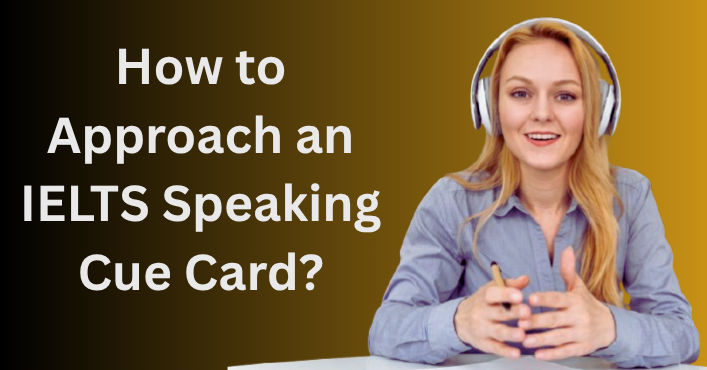
The cue card section or the IELTS Speaking 2 is the most important and challenging section of the speaking test. When presented with an IELTS cue card in the Speaking test, follow these essential steps to structure a confident and well- organized response:
- Take a few seconds to understand the topic, instructions, and guiding questions.
- Stay calm and focused. Use the one-minute preparation time wisely to organize your ideas and outline key points.
- Once the examiner signals you to begin, speak naturally and fluently without noticeable effort, covering all bullets given with the topic.
- Showcase your language skills by using a range of topic specific vocabulary and accurate grammar.
- Be descriptive: Show your language proficiency by adding detail and elaborating on your responses, rather than giving simple yes/no answers.
- Use examples: Whenever possible, add personal experiences or specific examples to support your answers. This makes your response more interesting and relevant.
- Ensure your response lasts 1-2 minutes so talk at length about the topic, maintaining a steady pace without rushing or pausing too much.Learn how word counting in IELTS and timing works to avoid being cut off.
Exam practice strategies for IELTS Cue Card
- Don’t memorize answers as it might sound unnatural. Focus on speaking naturally, even if it means giving a less polished answer.
- Practice with a stop watch. Get used to speaking for up to 2 minutes. Don’t worry, the examiner will stop you when you get to around 2 minutes.
- Record yourself speaking for up to 2 minutes. You can then listen back and spot any weaknesses.
Exam practice strategies for IELTS Cue Card
- Don’t memorize answers as it might sound unnatural. Focus on speaking naturally, even if it means giving a less polished answer.
- Practice with a stop watch. Get used to speaking for up to 2 minutes. Don’t worry, the examiner will stop you when you get to around 2 minutes.
- Record yourself speaking for up to 2 minutes. You can then listen back anspot any weaknesses.
1. Describe a house or apartment you want to live in.You should say:
- What it would look like?
- Where it would be located?
- What facilities this would have?
Explain why you want to live there.
2. Describe a time you spent a lot of money on something.
- You should say:
- What you bought?
- When you bought it?
- Where you bought it?
Explain why you spent a lot of money to buy it.
3. Describe a water sport you would like to try in the future.
- You should say:
- What sport it is?
- When and where would you do it?
- What preparations and equipment you would need?
Explain why you would like to try this sport.
4. Describe a shop near where you live that you sometimes go to.
- You should say:
- Where it is located?
- What items does it sell?
- How often you go there?
Explain why you go there.
5. Describe an indoor game that you liked to play when you were a child.
You should say:
- What is it?
- With whom did you play?
- How often you played it?
- How did you feel about it?
6. Describe something you couldn’t afford before but have recently bought it.
You should say:
- What the thing is?
- Why have you wanted it?
- How did you manage to buy it?
- Are you satisfied with it?
7. Describe a piece of clothing that someone bought for you.
You should say:
- What it was?
- Who bought it for you?
- Why s/he bought it for you?
Explain how you felt about learning this good news.
8. Describe a place where you read and write.
- You should say:
- Where it Is?
- How often you go there?
- Who you go there with?
Explain how you feel about It.
9. Describe a beautiful place to visit in your country.
You should say:
- Where it is?
- How to get there?
- What there is to do?
- When you are there?
Explain why you recommend this place.
10. Describe a time you visited a place with friends.
You should say:
- Where you went?
- What you did there?
- Who you were with?
Explain why it was a memorable experience.
Want help preparing for these topics? Read our IELTS cue card sample answers for detailed guidance and vocabulary ideas.
